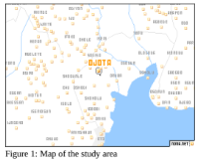Olusosun Landfill Leachate Induced Oxidative Stress in African Cat Fish, Clarias gariepinus.
Keywords:
Leachate, Oxidative Stress, Toxicity, Clarias gariepinusAbstract
An understanding of the toxicity of landfill leachate is crucial to know their potential effects upon human health and the ecosystems. In this study the effects of Olusosun landfill leachate (OLL) from Ojota in Lagos State, Nigeria on oxidative stress indices in African cat fish, Clarias gariepinus was investigated. Thirty Clarias gariepinus were equally divided into five groups. Control groups were exposed to fresh water and fish in the other groups were exposed to 10%, 20%, 40% and 60% OLL respectively for a period of seven days. Levels of malondialdehyde (index of lipid peroxidation), reduced glutathione, hydrogen peroxide generation and activities of Glutathione-S-transferase (GST), Glutathione peroxidase (GPX), Catalase and Superoxide dismutase (SOD) were determined in the Post Mitochondrial Fractions (PMFs) of the liver, kidney and gills of the fish. From the results, significant increase in lipid peroxidation, hydrogen peroxide generation, Catalase and GST activities were observed in all the organs of the fish exposed to OLL, however a decrease in reduced glutathione concentration was observed in these organs. An increase in SOD activity was observed in the liver and kidney of the fish but was depleted in the gills. In conclusion it may be inferred from this study that the significant induction of lipid peroxidation, hydrogen peroxide generation and alterations in antioxidant status in the organs of Clarias gariepinus in response to Olusosun landfill leachate exposure indicate that the leachate induced oxidative stress in the fish. This toxic effect may be passed on to man through the food chain
Downloads
References
Achuba, F.I. and Osakwe, S.A. (2003): Petroleum induced free radical toxicity in African catfish (Clarias gariepinus). Fish Physiol Biochem. 29 (2):97-103.
Adeogun Aina, O., Ilelabayo, M. Ogidan, Oju, R. Ibor, Azubuike, V. Chukwuka, Isaac, A. Adedara and Ebenezer, O. Farombi (2012): Long-Term Exposure to Industrial Effluent Induces Oxidative Stress and Affects Growth in Clarias gariepinus. Research Journal of Environmental and Earth Sciences 4(7): 738-746. ISSN: 2041-0492.
Adeyemi, O., Oloyede, O.B. and Oladiji, A.T. (2007a): Physicochemical and Microbial Characteristics of Leachate-contaminated Groundwater. Asian J. Biochem. 2(5): 343-348.
Akhgari, M., Etemadi-Aleagha, A. and Abdollahi, M. (2002): A brief review on oxidative stress and cardiac diseases. Mid East Pharmac.10:8-9.
Akinwumi, F.O. (2000): Aquatic Lives and the Environmental Changes. In: Contemporary Issue in Environmental Studies, Jimoh, H.I and I.P Ifabiyi (Eds). Haytee Press and Publishing, Ilorin.
Alegbeleye, W.O, Adetayo, J.A. and Ogunmoroti, T. (1991): Simple method for year-round breeding of Clarias gariepinus. Aquabyte 4: 8.
Bagchi, A. (1994): Design, Construction and Monitoring of Landfills. 2nd edition, John Wiley and Sons, New York. ISBN: 978-0471306818.
Baile, G.S., Williams, D.E. and Hendrick, J.D. (1996): Fish model for environmental carcinogenesis: the rainbow trout. Environ Health Perspect (suppl. 1) 104: 5-21.
Bailey, G., Hendrick, J. and Dashwood, R. (1992): Anticarcinogenesis in fish. Mutat Res 267: 243 – 250.
Bloor, M. C., Banks, C. J. and Krivtsov, V. (2005): Acute and sublethal toxicity tests to monitor the impact of leachate on an aquatic environment. Environment International 31: 269-273.
Canlı, M., Ay, O. and Kalay, M. (1998): Levels of heavy metals (Cd, Pb, Cu, Cr and Ni) in tissue of Cyprinus carpio, Barbus capito and Chondrostoma regium from the Seyhan River, Turkey. Tr. J. Zoology 22: 149-157.
Cheung, C.C.C., Siu, W.H.L., Richardson, B.J., De Luca-Abbott, S.B., Lam, P.K.S. (2004): Antioxidant responses to benzo-(a)-pyrene and aroclor1254 exposure in the green-lipped mussel, Perna Viridis. Environ Pollut 128:393-403, 21.
Cossu, C., Doyotte, A., Babut, M., Exinger, A., Vasseur, P. (2000): Antioxidant biomarkers in freshwater bivalves, Unio tumidus, in response to different contamination profiles of aquatic sediments. Ecotoxicol Environ Saf. 45:106-121.
Daniel, I. Olorunfemi, Glory, Jegede and Chidinma, C. Nnakwe (2011) : Comparative biomonitoring of raw leachates from some urban wastedumpsites using Allium cepa assay. Continental J. Environmental Sciences 5 (1): 6 – 12.
Dautremepuits, C., Paris-Palacios, S., Betoulle, S. and Vernet, G. (2004): Modulation in hepatic and kidney parameters of carp (Cyprinus carpio L.) induced by copper and chitosan.Comp Biochem Physiol C Toxicol Pharmacol.137: 325-33.
Dave, G. and Nilsson, E. (2005): Increased reproductive toxicity of landfill leachate after degradation was caused by nitrite. Aquatic Toxicology, 73: 11-30.
Dewhurst, R. E., Wells, N. C., Crane, M., Callaghan, A., Connon, R., and Mather, J. D. (2003): Multivariate relationships between groundwater chemistry and toxicity in an urban aquifer. Environmental Toxicology and Chemistry, 22(11): 2813-2821.
Dimitrova, M.S.T., Tsinova, V. and Velcheva, V. (1994): Combined effects of zinc and lead on the hepatic superoxide dismutase-catalase system in carp (Cyprinus carpio). Comp. Biochem. Physiol.108C: 43-46.
Dolk, H Vriheid, M., Armstrong, B., Abramsky, L., Bianchi, F. and Garne, E. (1998): Risk of congenital anomalies near hazardous-waste landfill sites in Europe: the EUROHAZCON study. Lancet.352:423–427.
Elliott, P., Briggs, D., Morris, S., de Hoogh, C., Hurt, C., Jensen, T.K. (2001): Risk of adverse birth outcomes in populations living near landfill sites. BMJ. 323:363–368.
Farombi, E. O., Ajimoko, Y. R. and Adelowo, O. A. (2008): Effect of Butachlor on Antioxidant Enzyme Status and Lipid Peroxidation in Fresh Water African Catfish, (Clarias gariepinus). Int. J. Environ. Res. Public Health 5(5): 423-427.
Farombi E.O., Adelowo O.A., and Ajimoko Y.R. (2007): Biomarkers of oxidative stress and heavy metal levels as indicators of environmental pollution in African cat fish (Clarias gariepinus) from Nigerian Ogun river. InternationalJournal of Environmental Research and Public Health 4: 158-165.
Farombi, E.O., Tahnteng, J.G., Agboola, A.O., Nwankwo, J.O., and Emerole, G.O. (2000): Chemoprevention of 2- acetylaminofluorene-induced hepatotoxicity and lipid peroxidation in rats by kolaviron-a Garcinia kola seed extract. Food and Chemical Toxicology 38(6): 353-541.
Fernandes, M. N. and Mazon A. F. (2003): 'Environmental pollution and Fish Gill Morphology. In: Val, A.L. Kapoor B.G. (Eds.), Fish Adaptations. Science Publishers, Enfield, USA. 203-231.
Habig W.H., Pabst M.J. and Jacoby W.B. (1974): Glutathione-S-transferases. The first enzymatic step in mercapturic acid formation. J Biol Chem 249:7130-7139.
Halliwell, B. and Gutteridge J.M.C., 2001. In: Free Radicals in Biology and Medicine. Oxford University Press, New York.
Jaffar, Y.M., Alkassasbeh, Lee Yook Heng and Salmijah, Surif (2009): Toxicity Testing and the Effect of Landfill Leachate in Malaysia on Behavior of Common Carp (Cyprinus carpio L.,1758; Pisces, Cyprinidae. American Journal of Environmental Sciences 5 (3): 209-217, 2009 ISSN 1553-345X.
Jollow, D.J., Michell, J.R., Zampaglione, N. and Gillete, J.R. (1974): Bromobenzene induced liver Necrosis:Protective role of GSH and evidence for 3, 4 -Bromobenzene oxide as the Hepatotoxic metabolite. Pharmacology 11:151 - 169.
Jos, A., Pichardo, S., Prieto, A.I., Repetto, G., Vázquez, C.M., Moreno, I. and Camean, A.M.( 2005): Toxic cyanobacterial cells containing microcystins induce oxidative stress in exposed tilapia fish (Oreochromis sp.) under laboratory conditions. Aquat. Toxicol.72: 261-271.
Kidd, P.M. (1991): Natural antioxidants first line of defense. A strategy for long-term survival. Biomedical-nutritional consulting 2:115-142.
Kjeldsen Barlaz, M.A., Rooker, A.P., Baun, A., Ledin A. and Christensen T. (2002): Present and long-term composition of MSW landfill leachate: A review, Crit. Rev. Environ. Sci. Technol. 32: 297–336.
Lasisi Adedoyin (2011): Leachate and Groundwater Quality in Lagos State, Nigeria, a paper presented at an in-house seminar for officers of Lagos State Environmental Protection Agency in June, 2011.
Li, X., Liu, Y., Song, L. and Liu, J. (2003): Responses of antioxidant systems in the hepatocytes of common carp (Cyprinus carpio L.) to the toxicity of microcystin–LR. Toxicon. 42: 85-89.
Longe, E.O and Balogun, M.R. (2010): Groundwater Quality Assessment near a Municipal Landfill, Lagos, Nigeria. Research Journal of Applied Sciences, Engineering and Technology 2(1): 39-44.
Maja Djogo, Aleksandar Dvornic,. Mirjana Vojinovic Miloradov, Jelena Radonic, Goran Vujic (2011): Determination of pollutant parameters in landfill leachate water of vojvodina region. Annals of Faculty Engineering Hunedoara- International Journal of Engineering. Tome ix. Extra Fascicule. ISSN 1584-2679.
Misra, H.P. and Fridovich, I. (1972): The univalent reduction of oxygen by reduced flavins and quinines. J. Boil. Chem. 247: 188-192
Munkittrick, K.R., McMaster, M.E., McCarthy L.H., Servas M.R and Van Dear Kraak G.J. (1998): An Overview of recent studies on the potential of pulp-mill effluents to alter reproductive parameters in fish. J.Toxicol Environ Health Pat. B1: 347 – 317.
Munkittrick, K.R., McMaster, M.E., Van Der Kraak, G. J, Portt, C., Gibbons, W.N., Fawell, A. and Gary, M. (2000): Development of methods for effect-driven cumulative effects assessment using fish populations: Moose River project. Published by the society of Environmental Toxicolgy and Chemistry (SETAC), 256.
Olarewaju, G.O., Sa’id, M.D. and Ayodele, J.T. (2012): Trace metal concentrations in leachates from open dumpsites in lokoja, kogi state, nigeria. Bayero Journal of Pure and Applied Sciences 5(2): 143 – 147.
Olivero-Verbel, J., Padilla-Bottet, C., and De la Rosa, O. (2008): Relationships between physiochemical parameters and the toxicity of leachates from a municipal solid waste landfill. Ecotoxicology and Environmental Safety, 70: 294-299.
Oman, C.B. and Junestedt, C. (2008): Chemical characterization of landfill leachates - 400 parameters and compounds. Waste Management 28: 1876-1891.
Omura, M., Inamasu, T. and Ishinish, N. (1992): Mutagenic activity of the leachate of municipal solid waste landfill. Mutation Research 298 (2):125-129.
Osaki, K., Kashiwada, S., Tatarazako, N. and Ono, Y. (2006): Toxicity testing of leachate from waste landfills using Medaka (Oryzias latipes) for monitoring environmental safety. Environmental Monitoring and Assessment 117: 73-84.
Oshode, O.A., Bakare, A.A.., Adeogun, A.O., Efuntoye, M.O. and Sowunmi, A.A. (2008): Ecotoxicological Assessment Using Clarias Gariepinus and Microbial Characterization of Leachate from Municipal Solid Waste Landfill. Int. J. Environ. Res., 2(4): 391-400, Autumn. ISSN: 1735-6865.
Ostman, M., Wahlberg, O. and Martensson, A. (2008): Leachability and metal-binding capacity in ageing landfill material. Waste Management, 28: 142-150.
Oygard, J.K., Gjengedal, E., and Royset, O. (2007): Size charge fractionation of metals in municipal solid waste landfill. Water Research, 41: 47-54.
Pandey, S., Parvez, S., Sayeed, I., Haque, R., Bin-Hafeez, B. and Raisuddin, S. (2003): Biomarkers of oxidative stress: a comparative study of river Yamuna fish Wallago attu (Bl. & Schn.). Sci Total Environ. 309:105-115.
Rajamanickam Vinodhini and Muthuswamy Narayanan (2009): Biochemical changes of antioxidant enzymes in common carp (Cyprinus carpio L.) after heavy metal exposure. Turk. J. Vet. Anim. Sci. 33(4): 273-278.
Reithmuller, N., Markich, S.J., Van Dam, R.A. and Parry, D. (2001): Effects of water hardness and alkalinity on the toxicity of uranium to a tropical freshwater Hydra (Hydra viridissima). Biomarkers, 6(1): 45-51.
Roberta, J.W and Timothy, J.P (1995): Free radicals. Clinical Biochemistry Metabolic and Clinical aspects, 765-777.
Sanchez-Chardi, Penarroja-Matutano, C., Riberiro, C.A. and Nadal, J. (2007): Bioaccumulation of metal and effects of a landfill in small mammals. Part II: The wood mouse, Apodemus sylvaticus. Chemosphere 70:101–119.
Sinha, A.K. (1972): Colorimetric assay of catalase. Anal. Biochem. 47: 389-394.
Sisinno, C.L.S., Oliveira-Filho,, E.C., Dufrayer E.M.C, Moreira, J.C. and Paumgartten, F.J.R. (2000): Toxicity evaluation of a municipal dump leachate using zebrafish acute tests. Bull. Environ. Contam. Toxicol. 64: 107-113.
Slack, R.J., Gronow, J.R., Voulvoulis, N. (2005): Household Hazardous Waste in Municipal Landfills: Contaminants in Leachate. Sci. Total Environ. 337: 119.
Slack, R.J., Gronow, J.R., Hall, D. H. and Voulvoulis, N. (2007): Household hazardous waste disposal to landfill: using LandSim to model leachate migration. Environmental Pollution 146: 501-509.
United States Environmental Protection Agency (USEPA), (1996): Acid digestion of sediments sludges and soils, Method-3050B.USEPA: Washington, DC.
United States Environmental Protection Agency, USEPA, (2002): http://www.epa.gov/waterscience/fish/. 100- 101.
Walker, C.H., Hopkin, S.P., Sibly, R.M. and Peakall, D.B. (2006): Principles of Ecotoxicology (Third Edition). Boca Raton, Florida, USA: Taylor Francis.
Ward, M.L., Bitton, G., Townsend, T. and Booth, M. (2002): Determining toxicity of leachates from Florida municipal solid waste landfills using a battery-of-tests approach. Environmental Toxicology 17: 258-266.
Wilhelm Filho, D., Giulivi, C. and Boveris, A. (1993): Antioxidant defenses in marine fish. I. Teleosts. Comparative Biochemistry and Physiology 106C: 409-413.

Downloads
Published
Issue
Section
License

This work is licensed under a Creative Commons Attribution-NonCommercial-ShareAlike 4.0 International License.







